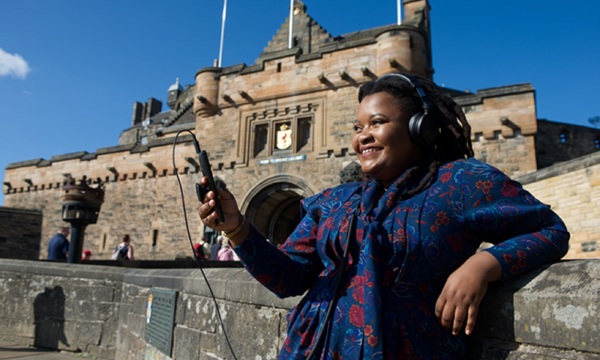A new installation, which opens at Edinburgh Castle tomorrow (Saturday 2 September), will take visitors on a sound walk through the historic site to map Scotland’s involvement in the creation of Zimbabwe’s streetscapes.
Nzira Yeparuware, which translates to ‘a path upon a rock’, runs until Thursday 30 November and has been created by Zimbabwe-born artist Tanatsei Gambura in partnership with Historic Environment Scotland (HES) which manages Edinburgh Castle, and the University of Edinburgh.
The project was developed from field recordings taken at a selection of sites in Harare in Zimbabwe which were named after streets in Scottish places including Aberdeen, Angus, Edinburgh, Fife, Jedburgh, Lanark, Midlothian, Orkney, Perth and more.
As visitors explore Edinburgh Castle, they will discover signposts at 10 locations across the castle, which correspond to a soundscape that should be listened to at that location. The sound files can be accessed by visitor’s own devices through a QR code.
At each location, visitors will hear a different soundscape which explores the lasting impact and complexities of Scottish colonialism, the connection of the Zimbabwean capital to Scotland through street names, and the parallels and contrasts between Edinburgh and Harare’s historical timelines.
In addition to field recordings, the soundscapes will also feature improvised musical responses performed in Edinburgh by members of the Composer's Orchestra as well as spoken words by the artist. The sounds play together in simulation to offer the visitor a multi-dimensional sonic experience.
Artist Tanatsei Gambura said:
"Working on this project with such committed collaborators has been great artistic fuel. I'm thrilled to be exploring a history that is both personal and collective whilst using the tangible material of Scotland's vast geography and heritage. I hope people will take up this opportunity to listen and discover how our landscapes are speaking back to us, and what they are saying."
Alison Turnbull, Director of External Relations and Partnerships at HES, said:
“Nzira Yeparuware offers visitors an immersive sound experience by international artist, Tanatsei Gambura, which combines field recordings with improvised musical compositions to explore colonialism’s link with the environment, including Scotland’s influence on street names in Harare. It is important that we highlight these less-well known aspects of Scotland’s past and present, and we’re pleased to be able to host this important work within Edinburgh Castle, providing a very personal, immersive opportunity to explore the links and complexities of colonialism.”
Dr Kirsten Carter McKee, Managing Imperial Legacies Research Manager at the University of Edinburgh, said:
"Nzira Yeparuware beautifully intertwines creative expression with geographical histories, sparking engaging conversations that shed light on Scotland's history from a colonial perspective. Working alongside Tanatsei has been incredibly inspiring for the Managing Imperial Legacies Network, as her artistic vision strongly resonates with the Network's aim to ensure that anti-racist conversations are included as a part of Scotland's historic narratives. As a testament to the enduring creativity of this installation, the University of Edinburgh is also delighted to be purchasing this work as a permanent part of the university art collections, for future generations of creatives and researchers to experience beyond its tenure at Edinburgh castle.”
This installation is part of Managing Imperial Legacies, which is a collaborative network partnership involving the University of Edinburgh, HES, and the Coalition for Racial Equality and Rights (CRER).
CRER said:
“Managing Imperial Legacies has sought to build conversations on the links and legacies of the transatlantic slave trade, empire and Scotland’s built environment. By looking at the ways Scottish imperialism has been reflected in multiple built environments, we can recognise and interrogate the colonial legacies of institutional white supremacy that still exist today.”
Nzira Yeparuware runs from Saturday 1 September until Thursday 30 November and is included in the admission price to Edinburgh Castle. Book tickets via the Edinburgh Castle website.
About Historic Environment Scotland (HES)
- We are the lead body for Scotland’s historic environment, a charity dedicated to the advancement of heritage, culture, education and environmental protection. It is at the forefront of researching and understanding the historic environment and addressing the impacts of climate change on its future, investigating and recording architectural and archaeological sites and landscapes across Scotland and caring for more than 300 properties of national importance. We are also the lead on delivering Scotland's strategy for the historic environment, Our Past, Our Future.
- Historic Scotland, Scran, Canmore, The National Collection of Aerial Photography (NCAP), The Engine Shed, Stirling Castle, and Edinburgh Castle are sub-brands of HES.
- View our press pack and keep up to date by registering to receive our media releases. Already registered? You can unsubscribe at any time by following the unsubscribe link, included in every email.
Follow HES
Twitter: @HistEnvScot | @welovehistory
Facebook: @HistoricEnvScotland | @VisitHistoricScotland
Instagram: @HistEnvScot | @historicscotland
For further information, please contact:
Laura Ely
Historic Environment Scotland Media Office
07721 959 962
communications@hes.scot

